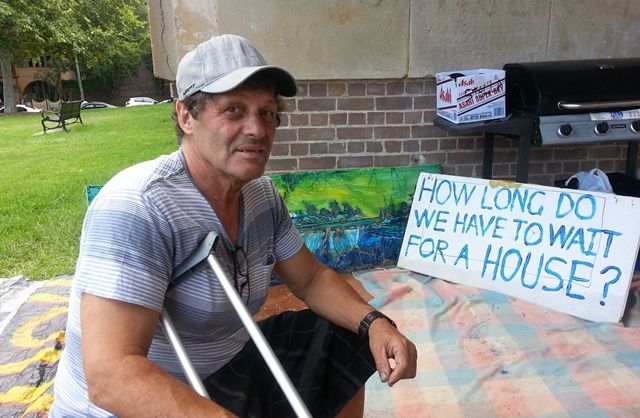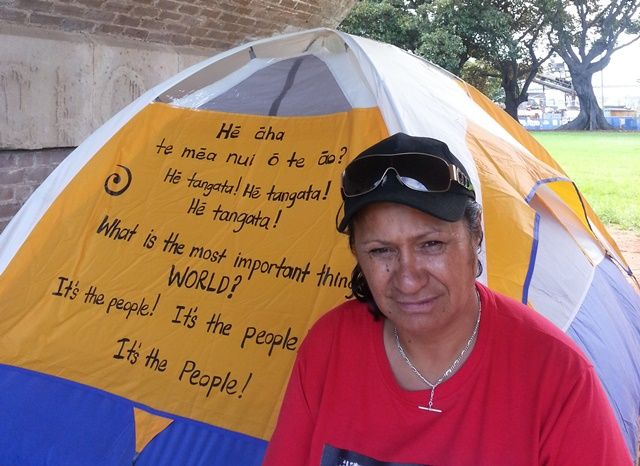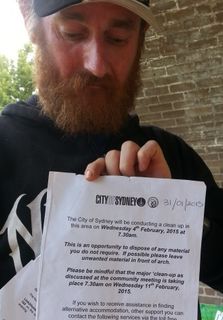Gabriela Zabala
Council officers backed by up to 40 New South Wales police officers confiscated the property of about 20 homeless people living under a Wentworth Park light-rail viaduct in Glebe, an inner-Sydney suburb, earlier this month. The callous attack on Sydney’s poorest and most vulnerable residents is in response to growing numbers of homeless people sleeping in the street in Sydney.
According to local residents, council officers arrived at the viaduct at around 7.30 a.m. on February 11 and began dismantling shelters and tents and seizing property. Chairs, tables and other vital necessities, including food and water, were thrown in large dumpster bins and removed.
Police told the homeless that they were not permitted to erect tents because this was “camping” and in violation of council laws. The residents were also told that they were only allowed to have one sleeping bag and two bags of possessions.
Following the operation, Sydney City Mayor Clover Moore, a so-called independent backed by the Labor Party and the Greens, issued a statement insisting that the council was not evicting the homeless from Wentworth Park and had “no plans to do so.”
The council, Moore cynically declared, was responding to complaints last year about “unauthorised camping” and had been “working with rough sleepers” about “keeping the area tidy.”
The Sydney City Council, in fact, told the homeless residents in January that the area would be subjected to a “clean up.” On February 6, the homeless were given an ultimatum, declaring that unless they removed tents, structures, furniture and other possessions that were “infringing on the public space,” these items would be forcibly confiscated.
Wentworth Park homeless told the World Socialist Web Site that the council seizure of their property was not the first attempt to force them out of the area. Last year Sydney council officers seized residents’ tents, personal belongings and medication, as well as their identification documents and papers.
Jimmy, 68, an art teacher who has post-traumatic stress disorder, anxiety, heart disease and other chronic illnesses, said council officers took his tent and most of his belongings.
 Jimmy
Jimmy
“I’m a human, not an animal,” he said. “If I have a home, I can create. What will my grandchildren say when they see how I live? When I returned to my home, everything was gone except a blanket on the ground. I like to live like a man, not a dog.”
Janet, 50, who has been living at the park for more than a year, previously worked as non-certified carer and a cleaner. She lost her job and became homeless because she could not pay the $200 weekly rent for a boarding house room. A New Zealand citizen, she is not entitled to any social welfare. Before becoming homeless, Janet volunteered with Occupation Sydney, which assists homeless people access social services. She also helps other park residents.
Janet explained that the homeless were forced to submit numerous applications for welfare and housing but they rarely heard back from these agencies. She had assisted one Wentworth Park resident apply for accommodation but four months later he was told by the state’s public housing provider to try and find private rental accommodation.
 Janet
Janet
Median rent for a two-bedroom house in Glebe is over $770 per week, a two-bedroom apartment $700 and one-bedroom apartment around $430 per week. The unemployment benefit for single people without dependents is only $515 per fortnight.
Janet’s niece Aggie, is unemployed and has lived under the viaduct for seven months. Although interviewed for several jobs, she has been unable to secure employment because she has no fixed address. She said that council operations against the homeless were occurring throughout Sydney.
“We didn’t know our rights and we allowed them to do this. They just took our things and dumped them in the bin,” she said. Without basic identification, she added, many residents had difficulty applying for welfare and jobs.
Aggie explained that there were a number of youth living in Wentworth Park. She said they were picked up once a fortnight by Department of Community Services (DOCS) workers. They were not provided any real assistance but taken for pizza and Coke and then dropped back off at the park in the evening.
Dean, 37, a former farm and hotel worker, was previously employed at a Kings Cross hotel. He lost his job and was evicted from his home by police. “We can’t present for work interviews without clean clothes,” he said.
 Dean
Dean
Local residents in Glebe were outraged by the council treatment of the homeless and have donated bedding, clothing, food and other items. Margaret, a public housing tenant in the area for more than a decade, said that the homeless were traumatised when council officers and the police arrived. “Tents, mattresses, belongings, one man’s false teeth and another’s passport were all thrown into a garbage truck and taken away,” she said.
Margaret explained that the viaducts were empty when she first moved to Glebe but that “more and more people have made these arches their homes. In the last couple of years it’s the worst it’s ever been. These are desperate, vulnerable people. It’s a terrible situation.”
The growing numbers of homeless, she added, was “an indication of the governments’ housing policy and the shortage of affordable housing…These cities cater for the high end of town. The disadvantaged are being squeezed and more and more people are making the street their home. As the high end of town develops, people are being cast off with little regard for the communities that are shattered.”
The council operation against Wentworth Park residents is a brutal response to the growing numbers of homeless people in inner-city Sydney. Homelessness Australia, the national peak body, estimates that there are over 28,000 homeless people in New South Wales with hundreds sleeping rough.
While Sydney is home to some of Australia’s wealthiest people, hundreds of poverty-stricken people are sleeping rough every night in Belmore Park, Woolloomooloo, St James, Circular Quay, Martin Place and at other city locations.
This month’s Sydney City Council operation runs in tandem with the ongoing cuts to public housing spending, the deliberate run-down and privatisation of state-owned housing by consecutive state government throughout Australia—Liberal and Labor alike.
In New South Wales alone there are over 57,000 eligible applications—or more than 120,000 people—on public housing waiting lists. At the same time public housing in inner-city Sydney such as Glebe, Surry Hills, Redfern, Waterloo and Millers Point is being privatised and opened up for further gentrification with huge profits going to developers and the real estate and finance industry.
The council assault on the homeless follows recent state and federal government cutbacks in homeless welfare spending. Two days before Christmas, the Abbott government slashed $21 million from annual homeless spending, and axed National Shelter, the Community Housing Federation of Australia and other agencies. In November 2013, the state Liberal government slashed $6 million in homeless funding to the Sydney area.
No comments:
Post a Comment